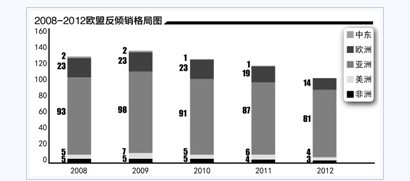
Anti-dumping has become a major trade remedy. The assessment report said that in recent years, major anti-dumping measures have targeted imports from Asia, especially China. In the past five years, the number of anti-dumping measures against Asian countries has accounted for 74%.
This is the 11th WTO trade assessment for the EU, and the evaluation period is from 2011 to 2012. The assessment report has more than 250 pages. The assessment of member countries’ trade policies is a routine agenda for the WTO.
The assessment report said that the EU's policies in the past two years have mainly focused on responding to the financial crisis, while there has been little change in trade policy, law and institutions. "Despite this, the EU has not retreated to trade protectionism, which itself is a positive signal."
In the report, the content related to “double opposition†is the most eye-catching. According to the European Commission data, in 2011, 0.3% of the EU's total imports were subject to “double-reverse†measures, which fell to 0.2% in 2012. In the past five years, the steel (market zone) industry and the chemical (market zone) industry have been the industries most affected by trade remedies.
In the past two years, the EU’s anti-dumping and countervailing measures have not changed. By the end of 2012, the EU had implemented 112 anti-dumping measures affecting 20 trading partners.
In the past two years, the EU has initiated 30 anti-dumping investigations, which is equivalent to the previous evaluation period. But not all investigations eventually led to the imposition of anti-dumping measures. For example, in 2009-2010, the final investigation of anti-dumping measures was less than 60%. In 2011, a total of 11 cases were implemented, 6 more than in 2010; in 2012, it was reduced to 3 cases.
However, some of the highest anti-dumping duties imposed on Asian countries are mostly targeted.
According to the report, from June 2010 to June 2012, the highest anti-dumping duties imposed by the EU included 82% of the synthetic fiber ropes in India and 148.3% of the polyester fibers in Korea. 71.9%, 64.3% of the specific sprayed molybdenum wire from China and Malaysia. The highest is 707% for stainless steel fasteners in Vietnam.
In the implementation of trade remedy measures, it is generally five years. If there is no expiry review, the measure will automatically expire. The European Commission alleged that the average length of EU anti-dumping measures is seven years, and about 17% of anti-dumping measures will be implemented for more than 10 years.
During the 2011-2012 evaluation period, 14 trade remedy measures were implemented for more than 10 years, and anti-dumping measures affecting 13 trading partners ended or expired. For example, anti-dumping measures against potassium chloride from Belarus and Russia in 1992 were terminated in July 2011.
Trade remedy measures can also be terminated before they expire. After one year of implementation, importers, exporters or EU manufacturers can request an interim assessment, which can be terminated on a temporary or overdue assessment. For example, in the anti-dumping measures on imports of ferrosilicon products from Russia and China, the EU terminated its measures against Russia in January 2012 and continued to implement it in countries such as China.
The assessment report said that the criteria for deciding whether to terminate anti-dumping measures is that the dumping margin is less than 2% of the import price.
In the EU countervailing investigation, the number of sponsors increased compared with the previous evaluation period. In 2011-2012, two countervailing final measures and one interim measure were implemented. In 2012, countervailing investigations focused on biofuels, steel products, solar panels and bicycles. Now, seven countervailing measures are being implemented and some measures have been extended.
The report also said that the EU does not implement anti-dumping and countervailing measures against Iceland, Liechtenstein or Norway. Although the three countries are not members of the European Union, they are in the EU economic zone.
In the modern industries, advanced ceramic component is very commonly used in many, many electron vacuum devices, like electron tubes, high voltage feedthru, high current feedthru, vacuum interrupter, vacuum capacitors/Thyristors, X-ray tubes and power switches and so on.
The key point is what a metal coating covers on the surface of ceramic body, or ceramic base to achieve the vacuum hermetical and sealing, such as nickle plating, sliver plating, gold plating, copper plating and Tin plating. The main features for Vacuum Ceramic Component as below:
-Extremely high bond/brazing strengths
-High mechanical strength
-Minimum electric resistance and vacuum tightness
-Excellent insulation
The typical form for vacuum ceramic component is to be as an insulator, ceramic packaging and ceramic body etc.
Vacuum Ceramic Component
Vacuum Ceramic Component,High Current Vacuum Ceramic Component,High Temperature Vacuum Component,Advanced Vacuum Chamber Ceramic Components
Jinghui Industry Ltd. , http://www.ceramictek.com